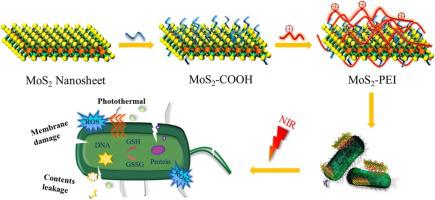Journal of Photochemistry and Photobiology A: Chemistry ( IF 4.1 ) Pub Date : 2020-07-10 , DOI: 10.1016/j.jphotochem.2020.112762 Wenbo Cao , Lin Yue , Imran Mahmood Khan , Zhouping Wang

|
The widespread bacterial infections accompanied by drug resistance, resulting from the abuse of traditional antibiotics, motivates researchers to develop effective antibacterial substitutes. Current researches have focused on positive antibacterial composites to promote interactions with bacteria, however facing challenges of unstable binding and low antibacterial efficiency. Here, we used covalent bonds to construct polyethylenimine modified Molybdenum disulfide (MoS2-PEI) nanocomposite to achieve tight combination and improve stability. We employed bifunctional groups including thiol and carboxylate group as a linker to firmly connect MoS2 and PEI. The covalent bonding strategy not only enhanced the stability of MoS2-PEI but also promoted the binding of MoS2-PEI to the surface of bacteria through electrostatic interaction. The distribution of MoS2-PEI around bacteria studies proved that positively charged MoS2-PEI could efficiently bind with negative bacteria. These two binding modes achieved accumulation of MoS2-PEI around bacteria and shortened the distance of reactive oxygen species (ROS) destruction. Moreover, the photothermal property of MoS2-PEI generated deep-penetrating heat and accelerated the oxidative stress. Under NIR light irradiation, MoS2-PEI exhibited synergistically prominent antibacterial efficacy against both Escherichia coli and Staphylococcus aureus and displayed long term bactericidal effect after 1 week storage. This work could contribute as an alternative to improve the effectiveness of current disinfection treatments.
中文翻译:

聚乙烯亚胺改性的MoS 2纳米复合材料具有高稳定性和增强的光热抗菌活性
传统抗生素的滥用导致广泛的细菌感染以及耐药性,这促使研究人员开发出有效的抗菌替代品。当前的研究集中在正性抗菌复合材料上,以促进与细菌的相互作用,但是面临着不稳定结合和低抗菌效率的挑战。在这里,我们使用共价键来构建聚乙烯亚胺改性的二硫化钼(MoS 2 -PEI)纳米复合材料,以实现紧密结合并提高稳定性。我们采用了包括巯基和羧酸酯基团在内的双官能团作为连接基,以牢固地连接MoS 2和PEI。共价键结合策略不仅增强了MoS 2 -PEI的稳定性,而且促进了MoS的结合2- PEI通过静电相互作用与细菌表面接触。MoS 2 -PEI在细菌周围的分布研究证明,带正电的MoS 2 -PEI可以与阴性细菌有效结合。这两种结合模式实现了MoS 2 -PEI在细菌周围的积累,并缩短了活性氧(ROS)破坏的距离。此外,MoS 2 -PEI的光热性质产生了深穿透热,并加速了氧化应激。在近红外光照射下,MoS 2 -PEI对大肠杆菌和金黄色葡萄球菌均表现出协同突出的抗菌功效并在储存1周后显示出长期的杀菌作用。这项工作可能有助于提高当前消毒处理的有效性。











































 京公网安备 11010802027423号
京公网安备 11010802027423号